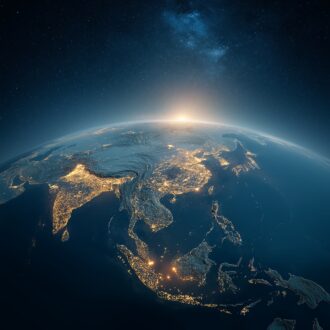A tsunami can be caused not only by an earthquake. There are also submarine volcanic eruptions, massive coastal landslides, or large meteorite falls.
Statistically, truly destructive tsunami waves result from submarine earthquakes with a magnitude of 7 or more.
Tsunami waves almost never come one at a time. The first wave is followed by a second, and sometimes a third and a fourth. And the first wave is usually not the most powerful.
In addition to tsunamis, there is such a phenomenon as a killer wave. This is a single wave of enormous height, which may number tens of meters. Killer waves can occur even in calm weather, and their cause is the simultaneous coincidence of many factors. Scientists managed to generate such a wave in laboratory conditions, and that is how the mechanism of their occurrence was revealed.
About 80% of all tsunamis in the world are registered in the Pacific Ocean.
The first scientific description of this destructive natural phenomenon was made in 1576 in Lima, the Peruvian capital. A powerful earthquake then sent waves 25 m high over the coast and 10 km inland.
In 2004, there was an earthquake in the Indian Ocean that is considered the most powerful earthquake in history (along with the Great Chilean earthquake, a controversial point). Its victims were about 300.000 people, and almost all of them died or disappeared not as a result of the tremors but because of the waves they generated. This tsunami had the highest death toll of any tsunami.
The deeper it is, the faster the wave travels, but it remains low. On the shoal, its speed drops sharply, and its height, on the contrary, increases.
In the open ocean, the tsunami wave height rarely exceeds half a meter. On the other hand, it travels at speeds up to 700-900 km/h, i.e. over 200-250 meters per second.
A tsunami is always more destructive than any storm, even the strongest. That is because during a storm only the surface layers of the water move, and at a depth of several tens of meters the water is quite calm. But in the case of a tsunami, the entire water column is involved, from the bottom to the surface.
A tsunami wave in the open ocean can be up to several hundred kilometers long. But more often they are shorter, although who will say that 10-20 kilometers is not enough?
It can take about an hour between wave strikes. But the first strike is always followed by a second one, with few exceptions.
Near shore, a tsunami can be as high as 30-40 meters, which is comparable to the height of a building of 10-12 stories.
Underwater earthquakes cause about 85% of all recorded tsunamis worldwide.
The highest tsunami in history was recorded on July 9, 1958 in Alaska, in the narrow bay of Lituya. A landslide caused huge masses of soil and ice to crash into the water from a height of 1,100 meters, generating waves up to 90 meters high. And that’s just the height of the wave itself – hitting the slope of the bay, the tsunami wave rose to a height of 524 meters.
Tsunamis can occur not only in the oceans and seas, but also in river deltas, with landslides being the most common cause. It occurs particularly often in Indonesia, where river tsunamis up to 15-20 meters high are recorded quite often.
Artificial tsunami waves can be created by underwater nuclear explosions. Such experiments were already conducted, even before the prohibition of nuclear tests.
The farther the sea recedes from the shore, the higher the wave will be. This is the most visible sign of an approaching threat.
In 1952, there was a powerful earthquake in the Pacific Ocean 130 kilometers from Kamchatka. The resulting tsunami waves, which reached heights of 15-18 meters near the shore, actually destroyed the city of Severo-Kurilsk.
Since a tsunami usually consists of salt water, sea or ocean water, it can poison freshwater sources and groundwater with this salt, and cause significant environmental damage.
Coconut palms growing on shores, oddly enough, often survive the impact of a tsunami. These trees are tougher than they look.
The ancient Greek scholar Thucydides first suggested about 2,400 years ago that destructive waves from the ocean or sea were associated with earthquakes.
In 2011, it was the tsunami waves that caused the accident at the Fukushima nuclear power plant in Japan. They reached heights of 40 meters.
A fall of a very large meteorite in the ocean can indeed cause a powerful tsunami, but it will only be dangerous if the impact occurs at a point no further than 25-30 km from the coast. Otherwise, the impact energy from a single point pulse will dissipate faster than the waves can reach the coast.
The maximum distance between tsunami waves generated by underwater earthquakes can reach 800-1000 km.
When approaching the shore, the speed of the wave drops to 80-100 km/h, i.e. reduces by 8-10 times.
The word “tsunami” comes from the Japanese language, and in the original consists of two characters. One means “wave”, and the other “bay” or “bay”.
Because the height of a tsunami in the open sea is usually very low, it is not capable of causing damage until it reaches the shallow waters. Therefore, ship crews may not even notice that they are walking on a wave that stretches for tens or hundreds of kilometers.
The rarest cause of a tsunami is a sudden change in the atmosphere. In about 5% of cases, volcanic eruptions are the cause, while another 7% are caused by landslides.
Water does not always recede from the shore when a tsunami approaches. If a wave has traveled a great distance and crossed the ocean beforehand, there may not be a sudden low tide.


